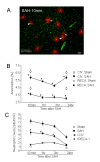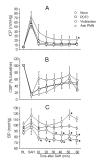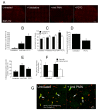Reduction of neutrophil activity decreases early microvascular injury after subarachnoid haemorrhage
- PMID: 21854561
- PMCID: PMC3170601
- DOI: 10.1186/1742-2094-8-103
Reduction of neutrophil activity decreases early microvascular injury after subarachnoid haemorrhage
Abstract
Background: Subarachnoid haemorrhage (SAH) elicits rapid pathological changes in the structure and function of parenchymal vessels (≤ 100 μm). The role of neutrophils in these changes has not been determined. This study investigates the role of neutrophils in early microvascular changes after SAH METHOD: Rats were either untreated, treated with vinblastine or anti-polymorphonuclear (PMN) serum, which depletes neutrophils, or treated with pyrrolidine dithiocarbamate (PDTC), which limits neutrophil activity. SAH was induced by endovascular perforation. Neutrophil infiltration and the integrity of vascular endothelium and basement membrane were assessed immunohistochemically. Vascular collagenase activity was assessed by in situ zymography.
Results: Vinblastine and anti-PMN serum reduced post-SAH accumulation of neutrophils in cerebral vessels and in brain parenchyma. PDTC increased the neutrophil accumulation in cerebral vessels and decreased accumulation in brain parenchyma. In addition, each of the three agents decreased vascular collagenase activity and post-SAH loss of vascular endothelial and basement membrane immunostaining.
Conclusions: Our results implicate neutrophils in early microvascular injury after SAH and indicate that treatments which reduce neutrophil activity can be beneficial in limiting microvascular injury and increasing survival after SAH.
Figures





Similar articles
-
Acute cerebral vascular injury after subarachnoid hemorrhage and its prevention by administration of a nitric oxide donor.J Neurosurg. 2007 Feb;106(2):321-9. doi: 10.3171/jns.2007.106.2.321. J Neurosurg. 2007. PMID: 17410718
-
VAP-1 blockade prevents subarachnoid hemorrhage-associated cerebrovascular dilating dysfunction via repression of a neutrophil recruitment-related mechanism.Brain Res. 2015 Apr 7;1603:141-9. doi: 10.1016/j.brainres.2015.01.047. Epub 2015 Feb 7. Brain Res. 2015. PMID: 25662771
-
Escape of intraluminal platelets into brain parenchyma after subarachnoid hemorrhage.Neuroscience. 2010 Feb 3;165(3):968-75. doi: 10.1016/j.neuroscience.2009.10.038. Epub 2009 Oct 25. Neuroscience. 2010. PMID: 19861151 Free PMC article.
-
Potential contribution of nuclear factor-kappaB to cerebral vasospasm after experimental subarachnoid hemorrhage in rabbits.J Cereb Blood Flow Metab. 2007 Sep;27(9):1583-92. doi: 10.1038/sj.jcbfm.9600456. Epub 2007 Feb 7. J Cereb Blood Flow Metab. 2007. PMID: 17293842
-
Subarachnoid haemorrhage: what happens to the cerebral arteries?Clin Exp Pharmacol Physiol. 1998 Nov;25(11):867-76. doi: 10.1111/j.1440-1681.1998.tb02337.x. Clin Exp Pharmacol Physiol. 1998. PMID: 9807657 Review.
Cited by
-
α7-Acetylcholine Receptor Signaling Reduces Neuroinflammation After Subarachnoid Hemorrhage in Mice.Neurotherapeutics. 2021 Jul;18(3):1891-1904. doi: 10.1007/s13311-021-01052-3. Epub 2021 May 10. Neurotherapeutics. 2021. PMID: 33970466 Free PMC article.
-
Early brain injury: a common mechanism in subarachnoid hemorrhage and global cerebral ischemia.Stroke Res Treat. 2013;2013:394036. doi: 10.1155/2013/394036. Epub 2013 Feb 28. Stroke Res Treat. 2013. PMID: 23533958 Free PMC article.
-
Differential regulation of matrix-metalloproteinases and their tissue inhibitors in patients with aneurysmal subarachnoid hemorrhage.PLoS One. 2013;8(3):e59952. doi: 10.1371/journal.pone.0059952. Epub 2013 Mar 28. PLoS One. 2013. PMID: 23555845 Free PMC article.
-
Clinical value of the low-grade inflammation score in aneurysmal subarachnoid hemorrhage.BMC Neurol. 2023 Dec 11;23(1):436. doi: 10.1186/s12883-023-03490-2. BMC Neurol. 2023. PMID: 38082254 Free PMC article.
-
Controversies and evolving new mechanisms in subarachnoid hemorrhage.Prog Neurobiol. 2014 Apr;115:64-91. doi: 10.1016/j.pneurobio.2013.09.002. Epub 2013 Sep 25. Prog Neurobiol. 2014. PMID: 24076160 Free PMC article.
References
-
- Scholler K, Trinkl A, Klopotowski M, Thal SC, Plesnila N, Trabold R, Hamann GF, Schmid-Elsaesser R, Zausinger S. Characterization of microvascular basal lamina damage and blood-brain barrier dysfunction following subarachnoid hemorrhage in rats. Brain Res. 2007;1142:237–246. - PubMed
-
- Park KW, Metais C, Dai HB, Comunale ME, Sellke FW. Microvascular endothelial dysfunction and its mechanism in a rat model of subarachnoid hemorrhage. Anesth Analg. 2001;92:990–996. pp. 990-996.; - PubMed
Publication types
MeSH terms
Substances
Grants and funding
LinkOut - more resources
Full Text Sources

